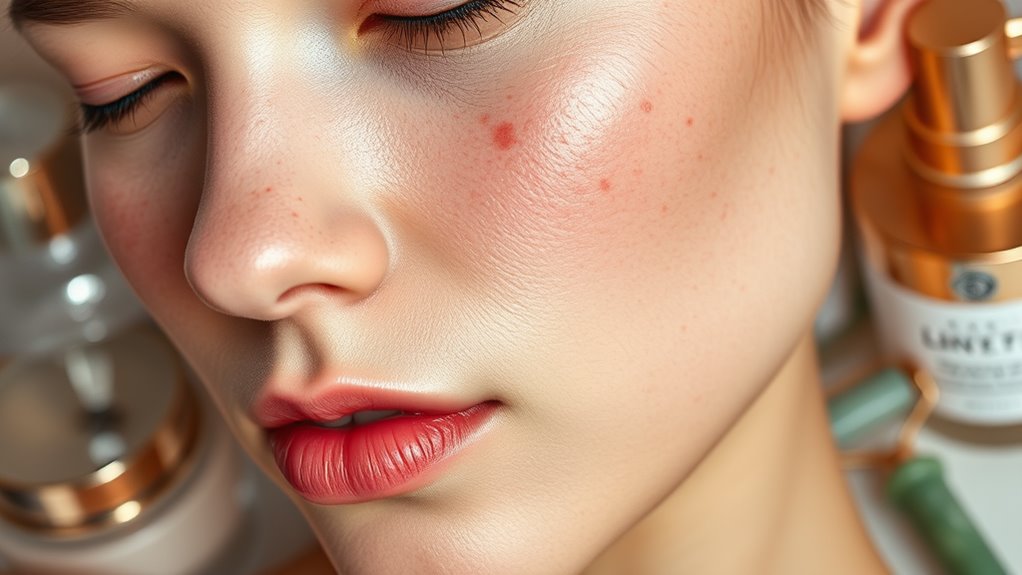Oily Skin in the Morning. Here’s What Your Skin’s Trying to Tell You
Oily skin in the morning often signals excess sebum production, driven by hormonal fluctuations, genetics, and environmental factors. These elements can combine to affect your skin’s hydration and oil balance. Increased oiliness may be linked to diet, stress levels, and your nighttime skincare routine. Understanding these influences helps you better manage your skin’s condition. To grasp the full picture and discover effective solutions tailored for you, explore the underlying causes further.
Key Takeaways
- Excess morning oiliness indicates your skin might be overcompensating for dehydration or damage to its natural barrier due to over-cleansing.
- Hormonal fluctuations during puberty, menstruation, or pregnancy can lead to increased sebum production, resulting in greasier skin in the morning.
- A diet high in processed foods and dairy can spike insulin levels, prompting more oil production and contributing to morning oiliness.
- Using heavy or comedogenic skincare products may clog pores, leading to increased oiliness; opt for lightweight, non-comedogenic formulas instead.
- Implement a consistent nighttime routine with gentle cleansing and lightweight moisturizers to help control oil production and prepare your skin for the next day.
Understanding Oily Skin: The Basics
Understanding oily skin is essential for managing its effects on your daily routine. Morning oily skin causes can often be attributed to several factors, including hormonal fluctuations, environmental influences, and lifestyle choices.
Excess sebum production during the night can result from increased androgen levels or heightened stress, leading to a greasy complexion upon waking. Additionally, using heavy creams or failing to cleanse properly can exacerbate oiliness.
To master your skincare regimen, you’ll need to identify these triggers and adjust your routine accordingly. Consider incorporating lightweight, non-comedogenic products that balance moisture without clogging pores. Simple solutions for managing oily skin can also make a significant difference in your daily routine.
Regular exfoliation can also help manage oil production and prevent breakouts, allowing you to maintain a clearer, more refined appearance throughout the day.
The Role of Genetics in Skin Oil Production
Your skin’s oil production is significantly influenced by genetic factors, which shape how your sebaceous glands function.
If oily skin runs in your family, you may find that your own skin exhibits similar traits due to inherited hormonal patterns.
Understanding these genetic connections can help you better manage and anticipate your skin’s behavior. Additionally, excess grease can be exacerbated by environmental factors, making it essential to adopt a tailored skincare routine.
Genetic Factors Influencing Oil
While many factors contribute to oil production in the skin, genetic predisposition plays a crucial role in determining how much oil your skin produces. Your genes influence the size and activity of sebaceous glands, which are responsible for oil secretion. Variations in specific genes can lead to increased oiliness or, conversely, drier skin.
| Genetic Variation | Impact on Oil Production |
|---|---|
| High sebum production genes | Increased oiliness, prone to acne |
| Low sebum production genes | Drier skin, less prone to acne |
| Balanced sebum genes | Moderate oiliness, healthy complexion |
Understanding these genetic factors can empower you to tailor your skincare routine effectively, addressing your unique oil production traits.
Family History of Oily Skin
Family history significantly influences oil production in the skin, often revealing patterns that reflect genetic inheritance. If your parents or siblings have oily skin, there’s a high likelihood that you may experience similar issues.
Research indicates that specific genes regulate sebaceous gland activity, affecting sebum production. Variations in these genes can lead to increased oiliness, particularly in areas like the forehead and nose.
Recognizing this genetic predisposition is crucial for developing effective skincare routines. You might need to adjust your products and treatments compared to those with drier skin types.
Understanding your family’s skin history allows for more informed choices, enabling you to manage your oil production more effectively and potentially mitigate its effects on your complexion.
Hormonal Influence and Genetics
Understanding the interplay between hormones and genetics is essential for grasping why some individuals experience oily skin more than others. Hormonal fluctuations, particularly during puberty, menstruation, and pregnancy, can significantly elevate sebum production.
Androgens, such as testosterone, stimulate sebaceous glands, leading to increased oiliness. Meanwhile, genetic predisposition can dictate the number and sensitivity of these glands. If oily skin runs in your family, you may inherit a heightened propensity for excess oil production.
This genetic component interacts with environmental factors, creating a unique skin profile. By recognizing these influences, you can tailor your skincare regimen strategically, employing targeted treatments that address both hormonal and genetic factors to manage oil effectively.
How Your Nighttime Skincare Routine Affects Oiliness
Your nighttime skincare routine plays a crucial role in determining how oily your skin feels in the morning. When you neglect proper cleansing, excess sebum, dirt, and makeup can accumulate, leading to heightened oiliness.
If you use heavy, occlusive products, they can clog pores, exacerbating oil production. Conversely, incorporating lightweight, non-comedogenic moisturizers and ingredients like niacinamide can help balance sebum levels.
Additionally, exfoliating at night with acids can remove dead skin cells, preventing pore blockage and promoting a smoother complexion. A balanced routine not only addresses current oiliness but also prepares your skin for the following day. Recognizing the impact of your evening regimen allows you to tailor it for optimal oil control and overall skin health. Furthermore, it’s essential to understand that moisturizing oily skin is crucial for maintaining hydration without increasing oiliness.
The Impact of Diet on Morning Oil Levels
Your diet plays a crucial role in determining morning oil levels on your skin. Certain foods can trigger increased oil production, while proper hydration helps maintain skin balance. Additionally, high sugar intake can exacerbate oiliness, highlighting the need for dietary awareness in your skincare routine. Consuming acne-triggering foods can lead to more oiliness and breakouts, emphasizing the importance of making mindful dietary choices.
Foods That Trigger Oil
Certain foods can significantly impact oil production on your skin, especially in the morning. High-glycemic foods, like white bread and sugary cereals, can spike insulin levels, prompting your sebaceous glands to produce more oil.
Dairy products may also exacerbate oiliness due to hormones present in milk, which can stimulate sebum production. Additionally, processed foods rich in unhealthy fats can lead to inflammation, further influencing oil secretion.
Monitoring your intake of these items is crucial for managing morning oil levels. Instead, focus on a balanced diet rich in whole grains, lean proteins, and healthy fats, which can help regulate oil production and promote skin balance.
Understanding these dietary influences is essential for mastering your skin’s health.
Hydration and Skin Balance
While many factors influence oil production, hydration plays a crucial role in maintaining skin balance, particularly in the morning. When you’re adequately hydrated, your skin’s oil production stabilizes, reducing excess sebum.
Conversely, dehydration prompts your sebaceous glands to compensate by producing more oil, leading to that unwanted morning shine.
Diet significantly impacts hydration levels; consuming water-rich foods, such as fruits and vegetables, enhances your skin’s moisture retention.
Additionally, proper hydration supports cellular functions, which regulate oil production. It’s essential to balance your fluid intake and nutrient consumption to achieve optimal hydration.
Sugar’s Role in Oil
As sugar consumption rises, so does its potential impact on oil production in your skin. High sugar intake leads to increased insulin levels, which can stimulate sebaceous glands, resulting in heightened oil secretion. This excess oil can contribute to clogged pores and acne development.
Moreover, sugar promotes inflammation, exacerbating skin conditions and further influencing oil production.
When you consume refined carbohydrates, your body experiences rapid glucose spikes, triggering hormonal responses that affect skin health. Maintaining a balanced diet with low-glycemic index foods can mitigate these effects.
Hormonal Fluctuations and Oily Skin
Hormonal fluctuations significantly influence the oil production in your skin, especially during certain life stages such as puberty, menstruation, or menopause.
Androgens, like testosterone, increase sebum production, which can lead to the oily complexion you might experience. During puberty, your body undergoes significant hormonal changes, stimulating sebaceous glands to work overtime.
Similarly, fluctuations in estrogen and progesterone during your menstrual cycle can trigger oiliness, particularly in the luteal phase. Menopause further alters hormone levels, often resulting in imbalanced oil production.
Understanding these cycles helps you anticipate changes in your skin’s behavior, allowing you to adapt your skincare routine accordingly. Additionally, recognizing that nighttime skincare routines can play a crucial role in oil regulation is essential for managing morning oiliness effectively.
Environmental Factors Contributing to Oily Skin
Environmental factors play a crucial role in the oiliness of your skin, especially in varying climates and exposure to pollutants. Understanding these influences is essential for managing your skin’s health effectively.
Consider the following contributors:
-
Humidity: High humidity can increase oil production as your skin tries to maintain moisture balance.
-
Pollution: Exposure to environmental toxins can irritate your skin, prompting excess oil secretion.
-
Sun Exposure: UV rays can damage skin barriers, leading to compensatory oiliness as your skin attempts to protect itself.
-
Temperature Fluctuations: Rapid changes in temperature can confuse your skin, triggering overproduction of sebum.
The Importance of Hydration for Oily Skin
Managing oily skin isn’t just about controlling oil production; hydration plays a significant role too. When your skin lacks moisture, it can trigger an increase in oil production as a compensatory mechanism. This creates a cycle where excess oil clogs pores, leading to breakouts.
To maintain balance, focus on lightweight, oil-free moisturizers that provide hydration without exacerbating oiliness. Ingredients like hyaluronic acid and glycerin attract moisture, ensuring your skin remains hydrated and healthy.
Additionally, drinking adequate water is crucial; it helps maintain skin elasticity and promotes overall skin health. By prioritizing hydration, you can optimize your skin’s function, reduce oiliness, and achieve a clearer complexion, ultimately mastering the management of oily skin.
Common Mistakes in Managing Oily Skin
While it might seem intuitive to strip away excess oil, many people make the mistake of over-cleansing their skin in an attempt to control shine. This approach can disrupt your skin’s natural barrier, leading to increased oil production.
Additionally, here are common mistakes to avoid:
-
Using harsh exfoliants****: These can irritate the skin and worsen oiliness.
-
Neglecting moisturizer: Oily skin still needs hydration to maintain balance.
-
Ignoring non-comedogenic products****: Using the wrong products can clog pores and exacerbate oiliness.
-
Skipping sunscreen: Neglecting sun protection can lead to long-term skin damage.
Recognizing these pitfalls is essential for managing oily skin effectively and achieving a clearer, healthier complexion.
Effective Solutions for Reducing Morning Oiliness
To effectively reduce morning oiliness, it’s crucial to implement a targeted skincare routine the night before.
Begin with a gentle cleanser that removes excess sebum without stripping your skin’s natural moisture. Follow this with a lightweight, oil-free moisturizer to maintain hydration without clogging pores. Incorporate a salicylic acid product to regulate oil production and prevent breakouts.
Additionally, consider using a clay mask once or twice a week to absorb excess oil and minimize shine. Avoid heavy creams or oils that can exacerbate oiliness.
Lastly, ensure adequate hydration by drinking water throughout the day, which helps balance your skin’s oil levels.




